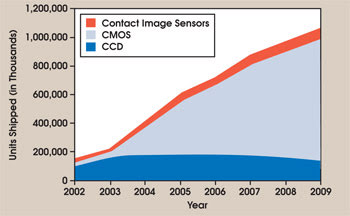Anne L. Fischer, Senior Editor
For years, people have been watching the CMOS sensor market to see when it might overtake the CCD one. According to “Image Sensors 2005: Camera Phones Drive CMOS Past CCDs in 2004,” a report from In-Stat of Scottsdale, Ariz., the camera phone market doubled CMOS shipments from 2003 to 2004. Shipments for camera phones — the largest single application for image sensors — tripled in that time period.
CMOS sensors are chosen for these low-cost consumer devices because of their low power consumption and their ability to integrate other functions on a chip. Supply should be less of an issue with CMOS than with CCD sensors, said In-Stat senior analyst Brian O’Rourke, because they are built on slightly tweaked CMOS production lines. Today, there are fewer fabricators of metal-oxide semiconductors than of CMOS, making production of CCDs, which relies on the former, more expensive.

Camera phones are the leading driver in the growing market for CMOS sensors, which doubled from 2003 to 2004, far exceeding shipments of CCD units. Courtesy of In-Stat.
Shipments do not indicate that CCD use is decreasing. These sensors remain the standard in many digital still cameras, security cameras and camcorders. At the lower end of the market, however, CMOS technology is beginning to dominate, according to the report.
Also highlighted are contact image sensors, competitors of CCDs for linear image sensor applications such as in scanners and fax machines. The sensors primarily are found in multipurpose, cost-sensitive applications, whereas linear CCDs are employed where resolution and sensitivity are key. Contact image sensors integrate several functions into a package that includes a sensor, a light source and a lens. In-Stat forecasts that their sales will remain just slightly above those for CMOS through 2009.
The report provides annual forecast numbers for the three types of sensors through 2009. In units shipped, CMOS technology is expected to lead the way, but in terms of revenue, CCDs are predicted to dominate as a result of high volumes and annual sales projections in several camera markets. Also included are profiles of the leading image sensor suppliers.
The 34-page report, released in October, sells for $3495. For more information, visit www.instat.com.